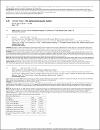Age-Related Differences of the Athlete`s Heart
| Author | Kneffel, Zsuzsanna |
| Available date | 2017-01-19T05:37:46Z |
| Publication Date | 2013-05-29 |
| Citation | Kneffel, Zsuzsanna, "Age-Related Differences of the Athlete`s Heart" 60th Annual Meeting & 4th World Congress on Exercise is Medicine® May 28-June 1, 2013 Indianapolis Convention Center Indianapolis, Indiana |
| Abstract | Purposes: Analyzing at which age exercise training induces characteristic modifications of heart and which of the characteristics of the athlete’s heart develop in the different ages? Methods: A systematic literature review including 188 publications. Results: In children age (<10-12 years) usually no or a small training effect can be detected. Approximately two years of intensive training are necessary to induce definite training effects based on some longitudinal (1, 2) and cross-sectional (3) studies. In the adolescent and young athletes (14-18 years), the left ventricle (LV) hypertrophy is already manifest (4). LV hypertrophy is less marked or missing at the older ages (50-80 years). Left ventricle muscle mass (LVMM) is higher in older endurance athletes than in age-matched non-athletes (5) but the difference between athletic and non-athletic subjects decrease continuously or disappears during the ageing. Authors are in agreement that long-lasting, high-intensity endurance trainings are the most effective ways to activate mechanisms, inducing the development of coronary circulation (6). No difference was seen between athletic and non-athletic children comparing their diastolic function (E/A). In the competitive age (19-35 years) athletes have a higher E/A than non-athletes (1.98 ± 0.37, vs. 1.73 ± 0.31, p = 0.013). In the 36-55 yr. age range physically active persons showed a higher E/A quotient than passive persons (1.574 ± 0.186 vs. 1.383 ± 0.069, p = 0.0327). At the older age in (age>55 years) physically active subjects also displayed significantly higher E/A quotients (1.104 ± 0.093) than passive persons (0.917 ± 0.104), p = 0.004. According to the Tissue Doppler Imagining (TDI) the mitral lateral annulus seems to be the most sensitive region to detect difference in the E’/A’ quotient. At the competitive age difference between athletes and non-athletes was significant (3.21 ± 0.64 vs. 2.32 ± 0.55, p = 0.0265) similarly to the transmitral E/A (1.97 ± 0.37 vs. 1.73 ± 0.31, p = 0.0228, < 0.05). Conclusion: Different characteristics of the athlete’s heart are manifested unequally during the lifetime: LV hypertrophy develops at the young age; differences reach the maximum in young adults (36-55 years) and are less marked in older subjects. Coronary capillary network seems to develop mostly in younger athletes, while a difference in diastolic function seems to be more manifest in the competitive age but also appear in older subjects. |
| Language | en |
| Subject | training aging cardiac adaptation |
| Type | Poster |
Files in this item
This item appears in the following Collection(s)
-
Sport Sciences (pre 2023) [206 items ]


